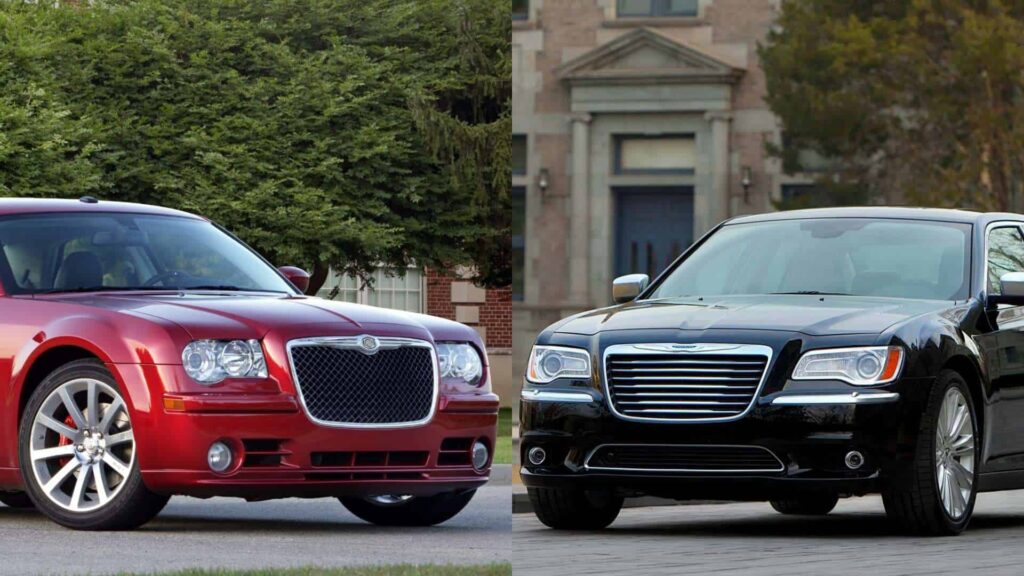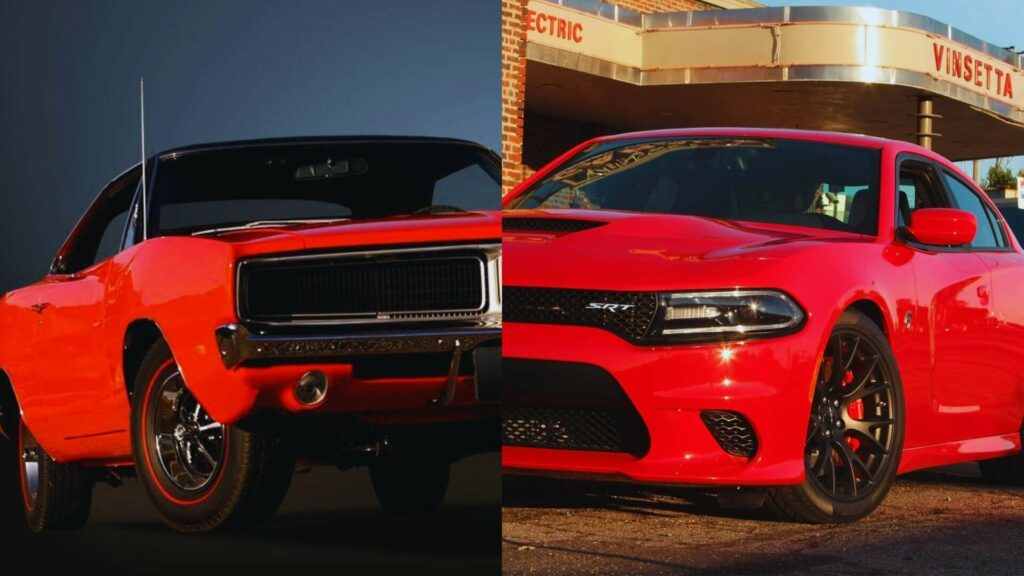The Chrysler 300 is one of the most recognizable American-made luxury cars in the full-size sedan (and station wagon) category today.
The model was first introduced as a concept car in 2003 and is still currently in production under the 2nd-generation “LD” designation.
Throughout the years, it has undergone a considerably extensive array of changes to its styling and specifications while still maintaining that iconic look it’s been known for.
But as the title suggests, we’re going to be focusing on the bolt pattern that the Chrysler 300 was fitted with throughout the years.
So if you own a Chrysler 300 yourself and plan on changing its wheels, then it’ll definitely be beneficial for you to know its bolt pattern as well as other relevant specifications.
What is the bolt pattern of a Chrysler 300?
Every Chrysler 300 model ever produced from 2004 until 2022 has a bolt pattern that measures 5×4.53 inches (5x115mm).
The bolt pattern has remained constant throughout the Chrysler 300 production run as the inherent dimensions that both 1st and 2nd-generation models have are very similar.
However, the bolt pattern isn’t the only thing that has stuck with the Chrysler 300 over the years.
As you read on, you’ll see how some of the Chrysler 300’s other bolt specifications have also been carried over from the 1st generation to the 2nd-generation model.
We’ve also thrown in the wheel specifications that each generation had from the factory, as these are quite important in figuring out what wheels can actually fit on it.
Wheel and Bolt Specifications of the Chrysler 300
To present the wheel specifications of the Chrysler 300, we have made a table for each generation containing all of the factory tire sizes and rim sizes according to the trim level.
Each trim level is indicated with the engine option fitted for that specific model.
As for the Chrysler 300’s bolt specifications, we have included its center bore diameter, type of wheel fastener, thread size, and torque tightening specification (torque spec).
This should give you an even better idea if a certain set of wheels that you want can actually fit snugly on your Chrysler 300’s wheel hub.
We would also like to note that the newer generation of the Chrysler 300 has pre-facelift and facelift production years.
For that reason, we have decided to separate their wheel specifications into their own respective tables.
Other than that, the bolt specifications will remain constant for all models within the same generation.
2nd-Generation Chrysler 300 (LD) (2011 to Present/2022)
The 2nd-generation Chrysler 300 first rolled off the factory on December 2010 for the 2011 model year.
Even though it was based on the then-new “LD” platform, it still closely resembled the LX platform that the 1st-generation model was built on.
But unlike the LX platform, the LD platform is only available in a saloon/sedan body style.
This newer generation underwent a facelift for the 2015 model year, which is what we currently see sold on Chrysler’s showroom floors today.
This facelift also changed the torque tightening specification of the 2nd-generation model from 150Nm to now 176Nm.
Apart from that, the rest of the bolt specifications remain exactly the same for both facelift and pre-facelift models.
Center Bore Diameter: 2.81 inches (71.5mm)
Wheel Fastener: Lug Nut (5)
Thread Size: M14x1.5
Torque Spec: 130lb-ft (176Nm) (Facelift)
110lb-ft (150Nm) (Pre-Facelift)
2015 to Present/2022 (Facelift)
The 2nd-generation facelift model has good variety in its wheel specifications depending on the trim level.
The facelift model is currently offered in four trim levels based on the engine that’s fitted. These engines include three V6-powered options and one V8-powered one.
The V8 engine in question has 5.7 liters of displacement and is an option for several of the facelift model’s packages (300C, 300S, and Luxury).
These V8-powered packages share the same two sets of wheel specifications as some of the 3.6-liter V6 RWD ones, namely the 300S and Luxury packages.
The rest of the 3.6-liter V6 RWD and AWD trims have their own set of unique tire size and rim size combinations.
2011 to 2014 (Pre-Facelift)
The wheel specifications for the pre-facelift model were actually not that different from the facelift ones.
What was different, however, was the number of trim levels that were offered at that time.
Unlike the facelift model, the pre-facelift one included a 6.4-liter V8-powered trim (6.4i) that actually had a similar tire size to the one on the 5.7-liter trim (5.7i).
This 6.4i trim was also known as the SRT8, and it had the biggest overall wheel dimensions alongside the 5.7i during the pre-facelift model’s production run.
The only difference between the two was that the tires on the 6.4i were “Z-rated”, and that it had a different rim thickness and offset as well.
The pre-facelift models initially started with only two 292hp V6-powered trims but then eventually got a third V6 engine with 300hp in 2013.
These three V6 engine trims were eventually passed on to the facelift models that we’ve already discussed above, thus the tire sizes and rim sizes are exactly the same too.
1st-Generation Chrysler 300 (LX) (2004 to 2010)
The 1st-generation Chrysler 300 was made in the LX platform back in 2004 and featured a slightly boxier exterior design compared to the 2nd generation.
It had a large chrome grill at the front, a low roofline, and a long hood that were all very characteristic of Chrysler’s designs back then.
It was offered in both 4-door saloon and 5-door station wagon body styles, contrary to the saloon-only 2nd-generation model.
As we’ve mentioned earlier, the bolt specifications of the 1st-generation Chrysler 300 closely resembles those of the 2nd-generation model.
The torque tightening specification for this generation was identical to the 2nd-generation pre-facelift models but otherwise different from the facelift ones.
Center Bore Diameter: 2.81 inches (71.5mm)
Wheel Fastener: Lug Nuts (5)
Thread Size: M14x1.5
Torque Spec: 110lb-ft (150Nm)
Regardless if it was the 4-door saloon or the 5-door station wagon variant, the 1st-generation Chrysler 300 only changed its wheel specifications based on the trim level.
Speaking of trim levels, it had a bit more compared to the 2nd-generation model.
A mixture of V6 and V8 trims equipped with either an RWD or AWD system gave the 1st generation a total of six trim levels, and that doesn’t even include the packages for each.
For the sake of clarity, all of the trim levels indicated without “AWD” were RWD models from the factory.
Moving on to the wheel specifications, both the 2.7i and 3.5i V6 trims shared the same two tire sizes and rim sizes.
The 3.5i AWD and 5.7i AWD trims only had one set of wheel specifications, which were actually the same as the second set of wheel specifications of the first two trims we’ve mentioned.
The non-AWD 5.7i had choices of either a 225mm tire size paired with an 18-inch rim size or a wider 245mm Z-rated tire size paired with a bigger 20-inch rim size.
The 6.1i, which was only used for the top-tier SRT8 package, also had the second set of “bigger” wheel specifications from the 5.7i.
In addition to this, the 6.1i SRT8 had an option to change the rear tires to wider 255mm ones while still retaining the same rim size.
How to Tighten the Bolts on the Chrysler 300
After learning about the Chrysler 300’s bolt pattern and other specifications, we find it essential to also learn about how to tighten its bolts (or lug nuts) properly.
Tightening wheel bolts aren’t as simple as tightening them in a circular order, but the tightening order for the Chrysler 300’s wheel bolts is still fairly straightforward nonetheless.
We’ve talked about how a lot of passenger cars on the road use a 5-lug pattern in our previous Chrysler 200 article.
This is also applicable for the Chrysler 300, as it uses 5 lug nuts just like its mid-size counterpart from the same brand.
With that considered, there’s only one proper tightening order for all 5-lug wheels, which is demonstrated in the diagram below.

As seen in the diagram, wheels with 5 lugs require following a star-shaped pattern in order to tighten them properly.
Following this pattern will ensure that there are no imbalances of tightening force distributed on the wheel’s mating surface.
This is why simply tightening the lug nuts in clockwise or counterclockwise order wouldn’t cut it, as the wheel gets pulled slightly into the direction of each lug nut that you tighten.
By the time you’ve finished tightening all of them, the last few bolts would have caused the first ones to loosen. Luckily, the pattern above decreases the chances of this happening.
In addition to the correct tightening order, you also need to remember to follow the recommended torque specification for your specific Chrysler 300 model.
Just to serve as a recap, the values are 130lb-ft for the 2nd-generation facelift model and 110lb-ft for both the 2nd-generation pre-facelift and 1st-generation models.
For safety reasons, only tighten the lug nuts to these values with a torque wrench when the vehicle is sitting firmly on the ground.
Otherwise, only hand-tighten the bolts halfway or at least until they’re snug enough to safely lower the wheels when you currently have the car jacked up.
General industry standards recommend driving the car for about 50 miles and then rechecking the torque values of the lug nuts again to see if they’ve loosened (or even over-tightened).
If you notice any changes in the torque values, retighten them accordingly. You may need to clean your wheel’s mating surfaces or change the wheel entirely if they keep coming loose.
When to Change the Tires on the Chrysler 300
Whether you own a Chrysler 300 or any other car, you definitely shouldn’t take their tires for granted if you want them to serve you well.
Thus, this part is dedicated to making sure that you’re aware of your Chrysler 300’s tires’ condition and when would be the perfect time to swap them out for new ones.
While the actual mileage may vary for each Chrysler 300 owner, the average lifespan of your tires would be around 60,000 to 75,000 miles (97,000 to 121,000km).
This mileage range may increase or decrease depending on your driving habits, the terrain to which your tires frequently traverse, or even your tire’s brand.
Another good indication of when you should consider changing your tires is if they’re already over 5 years old since you got them new.
The number of miles that you’ve driven matters less when your tires get this old, as the rubber compound on tires is subject to natural degradation and hardening over time.
But what if you don’t have a clue as to how old your tires are or how many miles you’ve already run on them? Well, we’ve got two common ways to measure your tire’s tread depth below.

The first way is by looking for your tires’ “tread wear indicator bars”, which are located deep between the treads.
Over time, your treads will gradually become thinner due to wear and tear. Once their thickness reaches the same level as these bars, then it’s time to change your tires.

The second way is to insert a penny upside between the treads and check how much of Lincoln’s head is hidden from view.
This is called the “penny test”, and if half of Lincoln’s head is still unseen, then your tires are still good to go.
However, if you can already see his entire head, as the left image shows, then your tires are already less than 1/16 of an inch thick.
This means that you’ve already gone past the legal tread depth limit and it’s definitely time to fit new tires on your car.
How and When to Rotate the Tires on the Chrysler 300
When rotating tires on the Chrysler 300 or just about any vehicle, for that matter, you need to be more aware of the distances you’ve driven in between intervals.
Tire rotation intervals are obviously shorter compared to tire change intervals, as the whole point of a tire rotation is to make sure your tires wear out evenly before your next eventual change.
When it comes to the actual tire rotation pattern itself, there are generally two things that should be considered when figuring out which would be the most appropriate one.
The first one is the drivetrain of the vehicle, and we already know for a fact that the Chrysler 300 was offered with either an RWD or AWD system.
The second one is whether or not the tires fitted are directional (unidirectional) or non-directional ones.
Generally, if you’re running non-directional tires, then by default, the vehicle’s drivetrain will be the determining factor.
It just so happens that both RWD and AWD vehicles use the same tire rotation pattern known as the “rearward cross”, which is demonstrated in the diagram below.

However, if your Chrysler 300 is fitted with directional tires, then the drivetrain becomes completely irrelevant.
This is because directional tires have treads that are designed to give optimal performance in one direction.
In order to keep them from facing the wrong direction, the tires are not crossed during rotations and are simply rotated from front to back (straight rotation) as the diagram shows below.

As for when you should be performing the tire rotation patterns we’ve discussed above, we will be referring to the vehicle’s drivetrain again.
For the RWD Chrysler 300 models, tire rotations should be performed every 5,000 to 7,500 miles (8,000 to 12,000km) driven on the tires.
In comparison, all AWD Chrysler 300 models should have their tires rotated earlier at 3,000 to 5,000 miles (4,800 to 8,000km).
Unlike RWD or FWD cars that only deliver power to either the front or rear wheels, AWD cars deliver power to all four wheels, which equates to more wear and tear on the tires on average.




